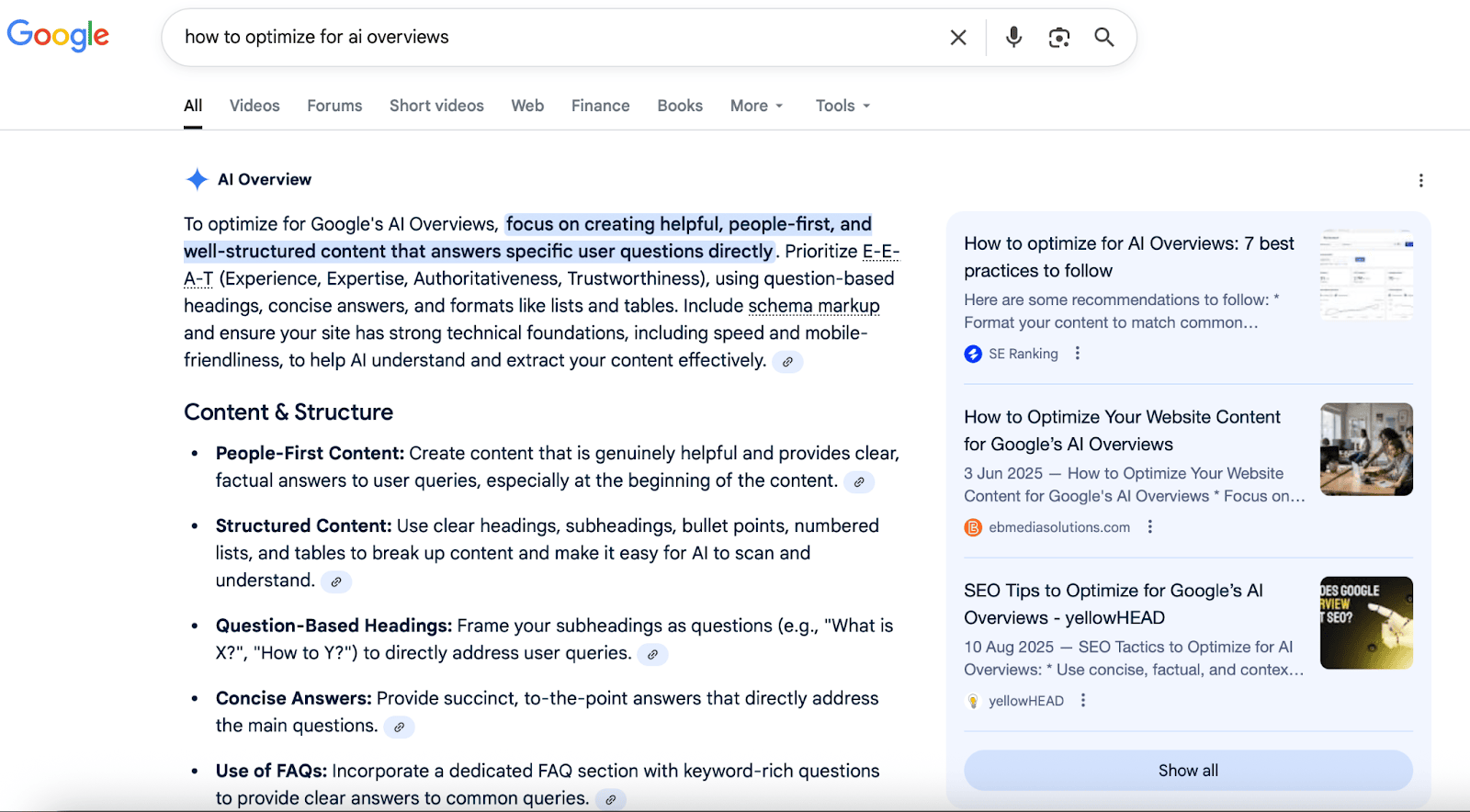Content Optimization Strategy: Top Tips for Rankings Growth

In the busy online space, standing out from the pack requires consistent effort. In particular, businesses of all sizes need SEO to get noticed. And the copy they share on their websites plays one of the biggest roles in this.
A smart content optimization strategy can get you ahead and drive more people to your site. How? By boosting your rankings, growing trust, and creating engagement. In this guide, we’ll tell you how to handle this process right for maximum outcomes!
Chapters
What Is Content Optimization in SEO?

Optimization is a crucial part of the overall content marketing strategy that consists of multiple stages. In particular, it involves a full audit, updating, and improvement of existing copy. SEO-wise, this process implies implementing and improving SEO approaches in your copy with the goal of making it more visible in SERPs and attracting more traffic, which can be later converted into sales and accomplishing larger marketing goals.
The Importance of Content Optimization for SEO
Content optimization is a part of on-page SEO. Its primary purpose is to improve your copy so that it ranks high in SERPs. However, the real benefits go far beyond visibility in search engines.
In reality, fine-tuning your articles can affect your brand in multiple ways:
- Create a brand image and emphasize your voice and values to become memorable.
- Improve user experience (UX) so that site visitors don’t bounce.
- Build niche authority and create trust.
SEO Content Marketing From A to Z
In order to gain maximum benefits from content optimization for SEO, you need to create copy that aligns with Google’s ranking factors and users’ needs. To accomplish this, you need to build an all-encompassing strategy that prioritizes quality, expertise, UX, and user needs.
Let’s look into the main tactics that should be involved for maximum rankings and conversions:
1. Creating Personas and Understanding Audience Needs
SEO content marketing begins with detecting what exactly your target audience needs. Remember that matching user search intent is one of the backbones of Google’s latest Quality Rater Guidelines. Thus, if you are looking to get rewarded by high rankings, placement in additional SERP features, and traffic, you want to know everything about your audience.
Analyze your existing customer base and the audience of your top competitors to create detailed buyer personas. Then, outline the journeys they follow when they interact with your brand. Then, identify the goals every group of prospects pursues. Their intent can be informational, navigational, commercial, or transactional, and it should align with their current position in your marketing funnel.
2. Targeting Relevant Keywords
When you have detailed audience groups, you need to refine your content optimization strategy with the right keywords. Leverage tools like Google Keyword Planner and insert your primary query into it. This will let you explore dozens of related terms that can be used as primary and secondary keywords. You can also use competitor analysis and SERP analysis to detect topical gaps that you can bridge.
Most importantly, when choosing your queries, pay attention to relevancy and competitiveness. You should also prioritize an intent-based approach in the process. Today, when Google aims for matching it, and when AI search becomes more and more popular, targeting the right queries based on user goals is more important than ever. For maximum convenience, create keyword clusters by topics and user purpose.
And, speaking of AI, don’t forget to target long-tail, question-based queries to boost your visibility in generated results along the way.
3. Optimizing for Readability
When SEO and content marketing meet, many businesses focus mainly on targeting the right keywords and strategically placing them in their copy. Yet, they often overlook the two empirical things that affect UX—structure and readability. However, even relevant and exciting copy can cause bounce if it’s hard to read and overwhelms readers.
In order to make your copy shine, make it well-structured and balanced. Use different levels of headings, short paragraphs, and short sentences for readability. Also, break large bulks of text with media.
In order to appear both in traditional SERPs and AI results, you need to use some extra tricks, structure-wise. Shorten your sentences further, prioritize conjunctions over full phrases, and use the active voice. Also, add glossary-like headings and provide quick and helpful answers to readers’ questions, and add
FAQ sections where possible. This should help you become visible in AI search.
Of course, optimizing for AI is still a little frustrating because algorithms evolve all the time. Still, starting now is a good strategy to stay ahead. And luckily, you can use specialized tracking tools like airanktrackertool.com to measure your visibility in AI results and adjust your approach based on data.
4. Do On-Page Optimization
While optimizing your copy is crucial for visibility and traffic, there are more things you can do on your pages to get noticed. We’re talking about refining other elements of your site, from every page’s URL to internal links. And each of these improvements will contribute to your standing in SERPs.
Here’s a brief on-page SEO checklist that you can follow:
- Write killer meta titles and descriptions. They should be descriptive and, ideally, begin with the primary keyword. You should keep them short, under 60 characters for titles and under 160 characters for descriptions, so that they show fully on smaller screens.
- Audit the URL structures of your pages. Make sure they’re neat, short, and easy to read. Only use lowercase and separate words with hyphens for readability.
- Also, make sure each URL describes what visitors will find on the page and insert your primary keywords naturally where possible.
- Integrate primary and secondary queries into your H1s and other subheadings. But keep it natural and don’t overuse keywords.
- Make sure all images on the page are also optimized. They should have descriptive file names and alt texts that also include keywords (where possible). And you should compress them for fast loading times.
- Spread internal links through your website naturally. They should keep visitors on your website for a longer time, helping them navigate through it more easily.
5. Pave Your Way Into Featured Snippets and Enrich Your SERP Appearance
Advanced SERP features, such as featured snippets, can give you a prime competitive advantage. Placed at the very top of the result page, they give you the so-called “position zero,” which will make your site even more noticeable. The same goes for Google AI Overviews.
To optimize for them, create small content sections with question-based headings and concise answers to them. Using tables and lists can also boost your chances.
Bonus: Don’t hesitate to implement schema markup if you haven’t yet. Rich results with added info often tend to drive more clicks.

6. Make Updates a Regular Routine
Regular refresh and updates of your copy are among SEO content optimization best practices for a reason. These tactics help you yield traffic and conversions from your existing articles for a longer time and, thus, improve your ROIs. Sticking to this tip is quite easy. All you need is to conduct regular audits of your pages to detect articles that start losing ranking authority. When you find them, use simple tricks to refresh them:
- Re-optimize for more powerful keywords.
- Update any outdated stats, facts, and ideas.
- Integrate new insights and tips.
These simple tips will help you keep your copy fresh for longer while also providing added value to your readers, which will positively affect your rankings.
7. Use Media and Alternative Content Types for Engagement
Google takes into consideration different engagement signals when determining your rankings. Bounce rate, conversions, sessions per page, and other engagement metrics demonstrate how valuable people find your website. Thus, boosting engagement should be one of the top priorities set in your content optimization strategies.
A good way to accomplish this goal is by adding various multimedia. Images, infographics, and videos drive attention and tend to improve dwell time. Also, using alternative copy formats and interactive formats, in particular, is a good way to drive engagement.
Conclusion
Today, content optimization is a must-have for every business, not an option. In the long run, improving your copy is about helping your target audience find you and, most importantly, managing how they see and remember you. This is the foundation of a strong brand, engagement, and loyalty.
As you now see, performing copy SEO requires a holistic approach with many steps. Luckily, with this article, you have a step-by-step guide that should help you reach your goals. And there is one last tip we want to leave you with – after creating and implementing your strategy, don’t forget to continuously measure success. Use analytical tools to track how your core metrics, such as rankings, bounce rate, and others, change and iterate your approach based on data.
Other Interesting Articles
- AI LinkedIn Post Generator
- Gardening YouTube Video Idea Examples
- AI Agents for Gardening Companies
- Top AI Art Styles
- Pest Control YouTube Video Idea Examples
- Automotive Social Media Content Ideas
- Plumber YouTube Video Idea Examples
- AI Agents for Pest Control Companies
- Electrician YouTube Video Idea Examples
- Top Software Development Companies
Master the Art of Video Marketing
AI-Powered Tools to Ideate, Optimize, and Amplify!
- Spark Creativity: Unleash the most effective video ideas, scripts, and engaging hooks with our AI Generators.
- Optimize Instantly: Elevate your YouTube presence by optimizing video Titles, Descriptions, and Tags in seconds.
- Amplify Your Reach: Effortlessly craft social media, email, and ad copy to maximize your video’s impact.
The post Content Optimization Tips to Boost Your SEO Rankings appeared first on StoryLab.ai.


Deixe um comentário